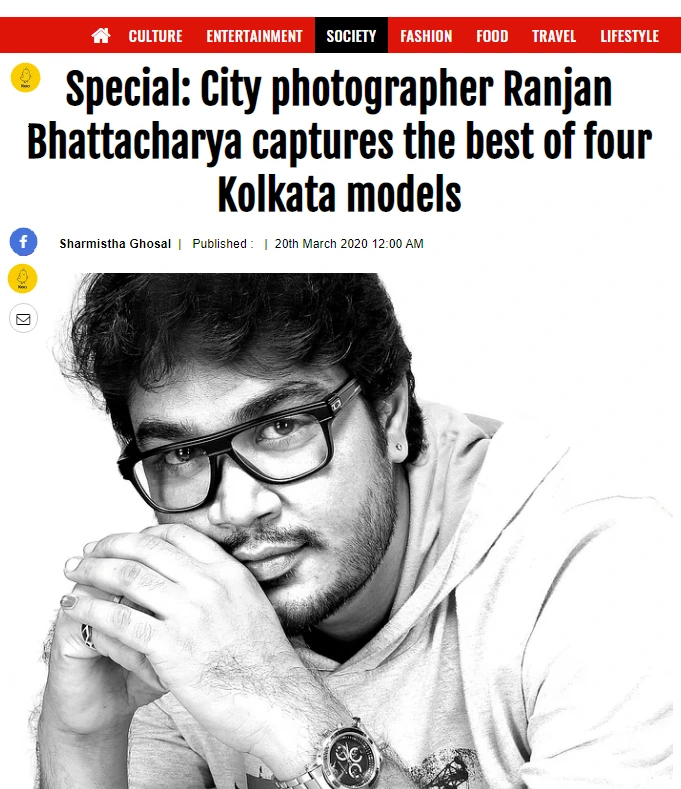Summary: Featured in The New Indian Express, Kolkata-based photographer Ranjan Bhattacharya reflects on his creative philosophy — finding beauty in imperfection, emotion over perfection, and storytelling through authentic frames. This editorial piece revisits the journey behind his feature, blending fashion, portrait, and advertising photography with an unfiltered human touch.
This article isn’t a repost — it’s a personal retelling of that moment in my own words. I wanted to revisit the experience that The New Indian Express captured, but from behind the lens — how it truly felt, what inspired each frame, and what still drives me to look for stories in the unexpected corners of fashion photography.
Every Photographer Has a Story Behind the Frame — Here’s Mine

Every photographer I know began with a promise to themselves—whether spoken or quietly kept—to see the world a little differently. For me, that promise was simple: don’t follow the beaten path. Long before the feature in The New Indian Express, I chose to treat each shoot like a small rebellion against predictability. I look for texture over polish, mood over perfection, and the truth in a moment rather than the staged ideal. That philosophy has shaped my work, my collaborations, and the way I tell stories through images.
The Philosophy: Why Imperfections Matter

Fashion photography is often judged by its gloss — smooth skin, flawless styling, perfect backgrounds. I respect that craft, but I’ve always been drawn to what sits on the other side of that perfection: humanity. Imperfection brings movement, context, and honesty. A crease in a sweater, the way light splits on a textured wall, a model’s unrehearsed glance — these are the things that make a frame feel lived-in rather than manufactured.
I don’t see imperfections as mistakes. I treat them as starting points. When I step onto a set, I’m not chasing an immaculate surface; I’m listening for an atmosphere. What kind of light does this place shelter? Where do shadows tell a better story than a reflector ever could? How can a garment, a stance, or an expression reveal something true about the person wearing it? Those questions guide my camera more than any checklist.
How It Began: The Early Experiments

Model Prantika Das — captured during Ranjan Bhattacharya’s early fashion experiments exploring natural light and emotion.
I didn’t start with large teams or big budgets. My early shoots were small, intimate experiments—friends, corners of the city, second-hand fabrics, and whatever light I could find that day. Those constraints taught me to see. When you don’t rely on production to craft a picture, you learn to use everything else: composition, timing, and the vulnerability of your subject.
One thing that never changed was my curiosity. I wanted clothes to feel like they belonged to the room, not the other way around. I wanted my subjects to bring themselves, not only to conform to a stylistic brief. That attitude made my images feel personal. And personal images get noticed—because they’re human first and fashionable second.
The December Shoot With Four Models—a Small Team, Big Impact

Models Sumana Singh and Anwesha Patra — part of Ranjan Bhattacharya’s editorial feature in The New Indian Express, capturing two distinct moods in one frame.
The Indian Express piece featured a shoot where I worked with four distinct models — each with a unique energy and bringing a distinct rhythm to the frames. That project proved how a small, tight-knit team can create images that speak louder than scale. We had minimal sets, simple styling, and an openness to improvisation. The result was editorial work that read like a short film, with small scenes stitched together intentionally.

Enakshi Ganguly and Prantika Das from Ranjan Bhattacharya’s celebrated Kolkata editorial — a study in contrasts, emotion, and minimalism.
Every shoot brings its own rhythm — and mine begins long before the first click. My way of directing is quiet and specific. I don’t give rehearsed smiles or rigid poses. Instead, I set a tone: a walk, a pause, a question, a leftover laugh. I ask the model to do something small—tilt the chin, move a hand—and then I wait. The best frames arrive in the waiting: a blink, a stray laugh, a micro-shift. Those moments carry the authenticity that editors respond to.
“I don’t direct faces — I direct emotions.” — Ranjan Bhattacharya
Technical Notes—What I Used and Why

Ranjan Bhattacharya with his Canon EOS 5D Mark III — discussing the tools and techniques that shape his fashion photography style.
I’ve always believed that gear should serve emotion, not the other way around. I prefer tools that let me move freely and respond to the mood in front of me. That day, I worked with a reliable prime lens for portraits, a wide lens for the environment, and a bit of off-camera light when nature needed a nudge. I gravitate toward lenses that keep skin alive—with grain, warmth, and honesty—instead of flattening it into perfection. For me, every technical choice must quietly obey the story I’m trying to tell.
When it comes to post-processing, I keep it minimal and deliberate. A little correction for tone and exposure, nothing more. I avoid the temptation to over-smooth or sterilize a frame. I want the image to feel tactile—you should almost sense the fabric, the pores, and the weight of air between light and shadow. That’s what makes a photograph breathe.
Collaborators—Why Teamwork Matters

Ranjan Bhattacharya with Nanda Majumder—a moment from their collaboration that reflects the spirit of trust, humor, and creative partnership behind every successful shoot.
Every great editorial is more than a photographer’s vision — it’s a shared belief in an idea. Behind every frame, there’s a small group that trusts instinct as much as direction. On that shoot, the makeup and styling crew were pragmatic, calm, and wonderfully solution-oriented. The production team kept things seamless, and the models brought generosity — the kind that no light setup can fake.
People often ask what makes a shoot truly work. For me, it’s never just about perfect lighting or composition. It’s about the team’s willingness to take small creative risks together. When everyone agrees to step slightly off-script, something real happens — you get images that feel original, honest, and alive.
The Ethics of Reusing Press Coverage—My Approach to Attribution
Original coverage of Ranjan Bhattacharya in The New Indian Express, written by Sharmistha Ghoshal. This image is used here with full credit and attribution to the publication.
Being featured by a respected outlet like The New Indian Express is an honour, and it also comes with a responsibility. If I share or republish excerpts of the original coverage, I always:
- Clearly credit the author and the publication.
- Link back to the original piece.
- Add my own thoughtful context — not just a copy-paste of the same words.
That way, my readers get new value, and the original publisher keeps the recognition they deserve. It’s how creative ecosystems should work: respectful sharing, not duplication.
Featured Story on The New Indian Express
Gratitude — to Sharmistha Ghoshal and The New Indian Express
Sharmistha Ghoshal — author of the original feature on Ranjan Bhattacharya, published in The New Indian Express Indulge. Image sourced from her official author page with full credit.
A heartfelt thank you to Sharmistha Ghoshal for covering our work with such sensitivity. Her words captured the quiet intent behind the pictures, and I’m grateful to The New Indian Express for giving a platform to small-scale, idea-driven editorial work. If you read the article and liked what you saw, please know that every image had the trust of someone who believed in the idea first.
Special thanks to Sharmistha Ghoshal for covering my work, and to the Indulge Express for featuring our story on their esteemed platform.
What I Want People to Take Away
If you’re a young photographer, don’t wait for the perfect set or the ideal brief. Begin with what you have. Make your constraints the reason to explore, not an excuse to postpone. The images that matter are the ones that reflect a way of seeing — yours.
If you’re a reader or a creative collaborator, come with patience. Great frames often require small risks and quiet trust. Be ready to try something that doesn’t look like anyone else’s feed. Because real creativity lives in what’s slightly uncertain — that space where instinct replaces perfection.
Want to See More?
If this piece moved you, explore more of my model portfolio photography work — every frame follows the same belief: seek truth, not polish. From fashion editorials to quiet personal projects, I try to document people the way light finds them — unposed, imperfect, real.
If you’d like to work together, drop a message — I prefer to keep projects small, collaborative, and meaningful. Because when intention and trust align, that’s when photographs stop being pictures — and start becoming stories.
Feature originally covered by: Sharmistha Ghoshal | The New Indian Express.

